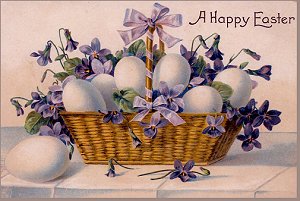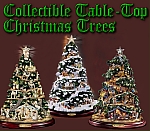|
|
The Myth of the Myth of the Easter Bunny - from Family Christmas OnlineTMA modern-day hoax popularized by "New Age" circles and reposted by gullible bloggers and the Huffington Post every spring is that the "Easter bunny's" origins trace to an ancient Saxon goddess named Eostre. According to the most common version of the story, Eostre saw a wounded bird. Realizing that even if she healed it, it would never fly again, she turned it into a rabbit. But the rabbit still laid eggs. Colored eggs. That would be a very convenient explanation for the history of the Easter bunny. But it's not an ancient myth - it was invented about 1987* but didn't receive widespread popularity until it was published in a children's magazine in 2002. Since then, many "New Agers" have gone way beyond that silly story to fabricate an entire mythology around it and to blame Christians for the fact that they are just now "finding out" about it. (Supposedly we've been keeping the newly-created "ancient legends" hidden since - in one version - before the birth of Jesus.) The short version is that no such myth was ever associated with Eostre or any similar goddess before 1987. In other words, the myth is the myth. But within the last half-century, New-Agers have added back-stories to the fairy tale, and back-stories to the back-stories. Now they claim that it is the "real reason" Christians celebrate the resurrection of Jesus. At the other extreme, hyper-legalistic sects have taken the myth of the "bird-bunny myth" so seriously that they actually believe that "Easter eggs" and the "Easter bunny" were once connected to the worship of a pagan goddess and therefore evil in and of themselves. Since the original "myth" is a hoax, and all of the back-stories are also hoaxes, both groups are wrong from the start, but neither group is anxious to admit they've been "had."
Why are Hares and Bunnies Universal Icons of Spring?I make a point of saying "hare," because that's how the "Easter bunny" tradition started in Germany. (The movie Rise of the Guardians is correct in using a hare for the Easter bunny, by the way.) Hares are seen most often in the spring. It's their "rutting season," when the simultaneous hectic activities of gorging themselves to make up for their winter fast, mating, and nest-building all happen at once.The urgency of the season often causes them to break cover, and sometimes act a little strange. In fact, that's where the term "mad as a By June, hares have all but disappeared. They've caught up on their meals, found a place to bed down, and learned where and when it is safe to forage away from human or carnivorous eyes. So if you see a hare or a bunch of hares grazing or traveling during daylight, it's probably early spring. Here in west-central Ohio, the cottontails do the same thing. It's not uncommon for Ohio mothers to hold their kids up to the window in March and early April and say, "Look, there's the Easter bunny." There is strong evidence that German Lutherans invented the notion that hares deliver Easter eggs, probably by the mid-1600s. The earliest written record is apparently from Geor Franck von Franckenau's Disputatione ordinaria disquirens de ovis paschalibus / von Oster-Eyern. Satyrae Medicae. XVIII (1682). Here's the only relevant bit of that I could find online: In Alsace and the neighboring regions those eggs are called rabbit-eggs because of a myth told to . . . children - that the Easter Rabbit lays the eggs and hides them in the grass of the gardens. So the children search for them even more eagerly, to the delight of the smiling adults.
By the way, the Dutch call the Easter Hare "Paashaas," using the name "Pasch," which is the universal name for Easter outside of German- and English-speaking countries. In short, the Easter Bunny (and his European relations) may not be a terribly "religious" icon, but he was invented by Christians. For some notes about secular icons like the Easter Bunny and Santa being associated with holy observations like Easter and Christmas, please check out our article Why Our Culture Needs Santa Claus (and the Easter Bunny). Why Do Some Folks Claim that the "Easter Bunny" is Connected to Fictitious Ancient Deities?I say fictitious because the deities involved were more or less invented in 1835 by linguist and fairy-tale compiler Jacob Grimm. Grimm was trying to find out more about a purported ancient Saxon goddess "Eostre," who is mentioned only once, briefly, in ancient literature. The German name for Easter - Ostern - is definitely related to the Saxon name Eostre. So based on such linguistic similarities, Grimm decided that the Saxon goddess "Eostre," must have had a German equivalent, to whom he gave the name "Ostara." (My apologies for leaving out the accent markings on these names, but they make the names unreadable on some computers.)Grimm admitted freely that there is no trace of such a goddess in ancient German literature. But he went on to propose that all traditional European spring festivals, icons, and modes of celebration must have started with worship of these deities. If Grimm had never invented Ostara, he would have had a great deal of difficulty explaining how the Osterhase, invented in Germany around the seventeenth century, was really a relic of previously undocumented Eostre worship in seventh-century England. Not to mention that there is nothing in ancient literature of any European culture to connect rabbits or hares to any ancient European goddess. But that wasn't a problem for the old fairy-tale editor. Grimm simply claimed that Eostra - and by extension Ostara - "probably" had a hare for a companion. Other writers reported Grimm's inventions and guesses as fact, then added their own inventions and guesses. The result was that by 1890 any number of reference books contained detailed information about Eostre, Ostara, and how they connected to modern-day Easter celebrations. Never mind that Ostara and virtually everything we "know" about Eostre were invented in 1835 and never supported by facts or further discoveries. (If you need to know more about Grimm's invented and reinvented goddesses and the supposed ancient myths that others subsequently created, please refer to our article Eostre: Frequently Asked Questions.) Back to the Easter Hare/Bunny, no researcher has ever definitively linked hares or rabbits (or colored eggs) to any ancient European goddess. There is no connection. Period. German Lutherans? There is a connection. But don't tell the Neo-pagans - if they ever reviewed the evidence that the Osterhase originated among Christians they'd have to give him up, and the bird-bunny is too important to their seasonal outreach efforts. What about Easter Eggs? Barring domesticated birds like chickens, most birds lay eggs only in the spring, so it's not surprising that, like the "March hare," eggs (and baby birds) are nearly universal symbols of spring. The earliest European appearances of springtime colored eggs are among Eastern Orthodox Christians, who used to color the eggs red, ostensibly to represent the blood of Christ, although now they use many colors (and excel in many kinds of decorations). Barring domesticated birds like chickens, most birds lay eggs only in the spring, so it's not surprising that, like the "March hare," eggs (and baby birds) are nearly universal symbols of spring. The earliest European appearances of springtime colored eggs are among Eastern Orthodox Christians, who used to color the eggs red, ostensibly to represent the blood of Christ, although now they use many colors (and excel in many kinds of decorations).
Moreover, there is a historical link to a specific Christian tradition. During the Middle Ages and Renaissance, Christians (what we would now call "Roman or Orthodox Catholics") were forbidden to eat eggs during Lent - about a six-week period before Easter. The only way to preserve eggs even for a few days was to hard-boil them. So on Easter, when Lent was officially over, the last several days' hard-boiled eggs would come out for breakfast and lunch. Would it be surprising if the eggs were tinted unusual colors as part of the celebration? Coming from a family that used to pickle hard-boiled eggs in vinegar and beet juice, I can't help but wonder if the original notion of coloring "pasch eggs" was related to an attempt to preserve them. But that is only speculation.
Easter Eggs and HyperlegalismUnfortunately some hyperlegalistic preachers are always on the lookout for new things to preach against. In such subcultures, there is constant digging for something nobody else has preached against yet, so leaders can show their "leadership."At one church we attended, Halloween was evil, so you could decorate with pumpkins in November, but not in October (when they might be perceived as Halloween decorations). Owls were evil all year-round. Then certain families decided that Christmas trees were evil, because ancient Celts used to decorate their homes with greenery in the winter. So those families got Christmas trees out of their households, then spent a season or two waiting for the rest of us to realize how much more spiritual that made them than the rest of the church. But nobody seemed to notice. Within a few years, many of the once-anathema trees gradually found their way back into most of those homes. Did the former tree-boycotters "fess up" to overreacting on that score, or apologize for the people they had tried to make feel bad? What do you think? Running low on cultural icons to rage against, some members came across the Eostre bird-bunny myth. Of course, that meant that "Easter eggs" were "of the devil." Since this particular fatwa hadn't been preached from our church's pulpit yet, it caught Shelia by surprise when she heard about it. Incredulously, she asked one of the young mothers who had given up Easter eggs if she was against eggs in general. "No, they're fine. Just not at Easter." Apparently for one week of the year eggs - especially hard-boiled eggs - were "of the devil," because we might be inadvertently worshiping ancient deities we've never even heard of who never had any connection to eggs, colored or otherwise. Does your head hurt yet?
By the way, if you're in a church, a denomination, or a "movement," where the list of apparently innocuous things that are "really of the devil" according to some arcane logic gets longer every year, get out now and find a church that believes we're saved by grace through faith, and that the Holy Spirit and the Bible are able to "convict of sin" without depending on the leaders' ever-growing and over-reaching list of "don'ts." Sooner or later, the hyperlegalists will start preaching against something you can't change (like having divorced or gay children) and they'll write you off anyway. So will your "friends" in the church, who will fall over each other in the rush to "shun" you first for fear that they'll be the next targets if the leadership detects any note of sympathy. Folks who've never been exposed to this dynamic will think I'm overstating it, but those of you trapped in ever-more-controlling groups know exactly what I'm talking about. Get out now. Yes I know it's scary. Staying where you are until your family becomes the next "object lesson" for someone ranting from the pulpit is worse. Don't ask me how I know. What About Plastic Eggs?We traded that church for another one didn't seem so legalistic on the surface. It turned out it was worse, but in different ways, so we didn't recognize it at first.One very silly "hiccup" occurred the year we were told we couldn't use plastic eggs to hide candy for the kids to hunt on Easter morning. Of course the grass would be damp, so we had to completely rethink the kind of candy we bought for the kids to find. That year, the "Easter egg hunt" was okay as long as we didn't use anything shaped like eggs. The next year, someone else was in charge of that activity and plastic eggs were no longer "of the devil." (No, we don't go to that church any more, either, but it took something far worse than the "plastic egg controversy" to drive us out. On the other hand, we've learned the hard way that little indicators like this one are often precursors of bigger problems on the horizon.) The Easter Bunny's Last LaughThis year (2014), our immediate family wasn't all going to be able to get together for Easter. In addition, the day before Easter - when we usually color eggs - was going to be taken up with other activities. So for the first time in maybe 30 years we weren't going to be coloring or hiding anything.But the Easter bunny had the last laugh on us. Several weeks before Easter, Shelia looked out the front window and saw a big cardboard box in the driveway. We live on a well-traveled road, so stuff - mostly trash - falling off trucks into our front yard isn't unheard of. I went out to investigate, and discovered it was full of brand new plastic Easter eggs, still sealed in the little plastic sleeves. I moved the box alongside the mailbox and left it out there overnight in case someone missed it and came back for it. But no one did. When it looked like it might rain, I put the box in the garage. The box was labeled "Easter Eggs 50 doz." And there was no reason to doubt the count. This year we gave plastic eggs to everyone we knew who could use them. After we had given out as many as we could, the rest went to our church, which will find plenty of use for them. But that wasn't all. Since we moved to our present home in 1987, our flower gardens have been watched over by a vintage cast-iron rabbit that the previous owner left behind. Long before we saw him, he had lost an ear. But he served his purpose just fine. A few weeks before Easter, Shelia noticed a ceramic rabbit based on the same mold sitting out with someone's trash up the street. What caused her to do a double-take was that it was also missing an ear. Admit it - if you'd had a matching rabbit at home, you would have stopped, too.
In lieu of having a family Easter egg hunt this year, we invited another couple from church to share Easter dinner with us. I'm sure someone will claim that Baal-worshippers used to have friends over on feast days, and therefore we were really worshipping Baal or something. But it seemed like a compassionate, Christian thing to do at the time. Sometimes company is just company, sometimes a rabbit is just a rabbit, and sometimes an egg is just an egg. Celebrate your faith and the truths of the Bible, not other people's paranoia. If you have any corrections, comments, or additions you would like to make about this article, please contact me and I will be glad to hear from you. Have a Blessed Easter - Thanks for stopping by. God grant you and your loved ones grace and a spirit of generosity and service this season. Paul D. Race, Family Christmas Online * As far as I can tell the Eostre bird-bunny story dates back to an article published in a K-12 school resource by feel-good writer and frequent Oprah guest Sarah Ban Breathnach. In 1990, she incorporated the article's content in Mrs. Sharp's Traditions: Reviving Victorian Family Celebrations of Comfort & Joy. Then, in 2002, Jean-Andrew Dickmann published a version of Breathnach's story as "The Coming of Eostre" in Cricket Magazine a "Weekly Reader" sort of publication. To give Dickmann the benefit of the doubt, I think she simply meant to tell a "fairy tale," like "How the Leopard got His Spots," and had no idea that people would take it seriously. However, the story resonated with people who couldn't tell the difference and - in some cases at least - were looking for anything that supported their (unfounded) claim that Christians "stole" Easter from pre-Christian religions. From that point on, it has been retold hundreds of times, and has become a doctrinal staple of some NeoPagan groups. If you can find evidence that the bird-bunny myth appeared anywhere in print dated before 1987, please let me know - I'd hate to blame Breathnach entirely for something that she had actually found elsewhere and republished in "good faith." But vague references don't count. Neither do books published 2011 claiming that the legend is "thousands of years old."
For more information about Easter, Easter traditions, and related subjects:
To return to the Family Christmas OnlineTM Home Page, click here.
|


|


| 
| 
| 
| 
|
Note: Family Christmas OnlineTM is a trademark of Breakthrough Communications(tm) (www.btcomm.com).
All information, data, text, and illustrations on this web site are
Copyright (c) 2006, 2007, 2008, 2009, 2010, 2011, 2012, 2013, 2014 by Paul D. Race.
Reuse or republication without prior written permission is specifically
forbidden.
Family Christmas Online(tm) is a participant in the Amazon Services LLC Associates Program, an affiliate advertising program designed to provide a means for sites to earn advertising fees by advertising and linking to amazon.com.
For more information, please contact us
| Other Christmas resources and affiliated sites: | ||||||
| - Christmas Memories and Collectibles - | ||||||
 |

|

|

|

|

|
|
| - Family Activities and Crafts - | ||||||
 |

|

|

|

|

|
|
| - Trains and Hobbies - | ||||||

|

|

|  |

|
 |
|
| - Music - | ||||||

|

|
 |

|

|
 |
|